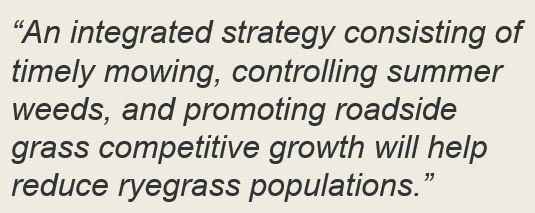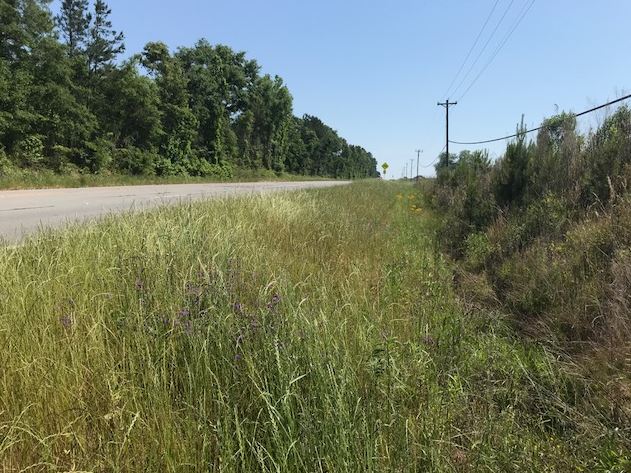Posted by Michelle Vignault
Italian ryegrass (Lolium multiflorum) is one of the most problematic winter weeds of roadside vegetation. Ryegrass establishes from seed in the fall when soil temperatures drop below 70° F.

Plants overwinter in a vegetative state followed by significant growth when temperatures warm up in spring. Ryegrass grows well under cool conditions when roadside grasses are dormant or have limited competitive growth. Plants exhibit erect growth that reaches three to four feet in height upon maturity (Picture 1). Consequently, ryegrass may shade out warm-season grasses during spring greenup that causes significant stand thinning by summer.
Italian ryegrass is a prolific seed producer that contributes to annual infestations. The seedhead is a long spike with at least ten alternating florets. The florets contain long awns that are not present on perennial ryegrass (Lolium perenne). Seed dispersed in late spring can remain dormant in soil for years. Another key characteristic to help identify ryegrass, without seedheads, is the clasping auricles at the junction of the leaf sheath and blade. The auricle may help practitioners identify a ryegrass from other weedy grasses, such as tall fescue.
Control Strategies
Vegetation managers can make modifications to their maintenance programs for reducing annual ryegrass establishment in fall. For example, mowing before seedhead formation can suppress Italian ryegrass growth and inhibit the production of viable seed in spring. Ryegrass often exhibits rapid regrowth after mowing that may warrant additional management inputs for suppression. Modifications in cultural practices that are applicable to other cropping systems, such as pastures and forages, are often not applicable for most roadside managers. Therefore, an integrated strategy consisting of timely mowing, controlling summer weeds, and promoting roadside grass competitive growth will help reduce ryegrass populations.

Preemergence herbicides can prevent the establishment of ryegrass in fall. Dinitroanilines, or WSSA Group 3 herbicides, include oryzalin (Surflan, others), pendimethalin (Pendulum, others) and prodiamine (ProClipse, others). These herbicides inhibit microtubule assembly during cell division of young roots and shoots after germination that prevents ryegrass establishment. Indaziflam (Esplanade) inhibits cellulose biosynthesis and offers an alternative mode of action to DNA herbicides for ryegrass control in warm-season grasses. Applications should be timed when soil temperatures drop below 70° in fall. Most preemergence herbicides do not control established ryegrass and may provide unacceptable control when applications are made after initial germination in fall.
Bermudagrass managers may use acetolactate synthase (ALS) inhibitors in early winter for postemergence ryegrass control. These herbicides include Escort (metsulfuron), Oust (sulfometuron), Pastora (nicosulfuron + metsulfuron), Derigo (thiencarbazone + foramsulfuron + iodosulfuron), and Matrix (rimsulfuron). Bahiagrass managers may use Oust and Derigo for postemergence ryegrass control, but most other ALS-inhibitors cause unacceptable injury. Postemergence herbicides are more effective in early winter, compared to spring timings, because of the size and maturity of plants at application. The optimum timing for postemergence control of Italian ryegrass is when plants are less than 6 inches in height. Italian ryegrass is generally susceptible to postemergence herbicides in early winter prior to the onset of freezing temperatures and before seedhead emergence. Most of these herbicides require a non-ionic surfactant at 0.25% v/v of spray solution (1 qt/100 gal) to enhance foliar uptake and spray retention.
Glyphosate (Roundup, Accord, others) is a nonselective herbicide widely used on bermudagrass roadsides for ryegrass control in winter. Moderate rates of glyphosate in bermudagrass, such as 0.125 to 0.25 lb acid equivalent per acre, generally do not affect spring transition when applied in winter. Envoy Plus (clethodim) and Segment (sethoxydim) are Group 1 herbicides (ACCase-inhibitors) that effectively control ryegrass in dormant bermudagrass. Roadside managers should not use these herbicides in spring if delayed green-up or growth inhibition to bermudagrass is unacceptable. These herbicides should never be applied to bahiagrass or tall fescue roadsides.
Several combination products with different modes of action or ryegrass control have recently been labeled for bermudagrass roadsides. Piper (flumioxazin + pyroxasulfone) is a pre- and postemergence herbicide for controlling ryegrass on bermudagrass roadsides. The herbicides in Piper offer alternative modes of action (Group 14 and 15) to the ALS-inhibitors and glyphosate. Piper must be applied at 10 oz/acre for effective postemergence control of ryegrass in early winter before ryegrass is at 6” in height. Piper requires the use of a crop oil concentrate at 1% vol/vol to enhance foliar uptake and control. Tank-mixtures with glyphosate will improve efficacy on ryegrass but should only be applied when bermudagrass is completely dormant.
Another combination product for ryegrass control in bermudagrass roadsides is Cleantraxx (penoxsulam + oxyfluorfen). This combination offers postemergence control of ryegrass in early winter with residual preemergence control in winter. The efficacy of Cleantraxx will significantly improve when glyphosate is applied in tank-mixtures. Adding glyphosate provides another mode of action for postemergence ryegrass control and provides end-users greater application timing flexibility with applications. Cleantraxx also controls many winter annual broadleaf weeds that may exhibit competitive growth with bermudagrass during spring transition.
Roadside managers have no selective herbicides available for postemergence control of ryegrass in tall fescue or other cool-season grasses. Therefore, the use of dinitroaniline herbicides for preemergence control will be needed if ryegrass populations are problematic in roadside fescue.
Herbicide Resistence
Rotation Program
A major limitation to postemergence control of annual ryegrass is herbicide resistance. Resistance develops from selection pressure caused by repeated use of the same herbicide or mode of action over years. As susceptible biotypes are controlled by a particular herbicide over years, biotypes that are naturally resistant to this mode-of-action may spread in these areas. This type of selection pressure will shift a ryegrass population from susceptible to resistant biotypes over years. Agronomists should have an appreciation for the potential development of resistance to these herbicides and plan rotation programs to delay or avoid the onset of resistance.
Practitioners should rotate herbicides for ryegrass control in sequential application programs. Tank-mixtures of two herbicides with different modes of action will also be critical to control biotypes with resistance to a particular mode of action. For example, tank-mixing Oust (sulfometuron) with glyphosate at 0.25 lb ae/acre makes an excellent combination to delay resistance in roadsides. Incorporating herbicides that offer alternative modes of action to these chemistries, such as Cleantraxx or Piper, alone or in tank-mixtures with other herbicides will also be important for resistance management. Learn more at www.clearion.com
Next month: Broomsedge
